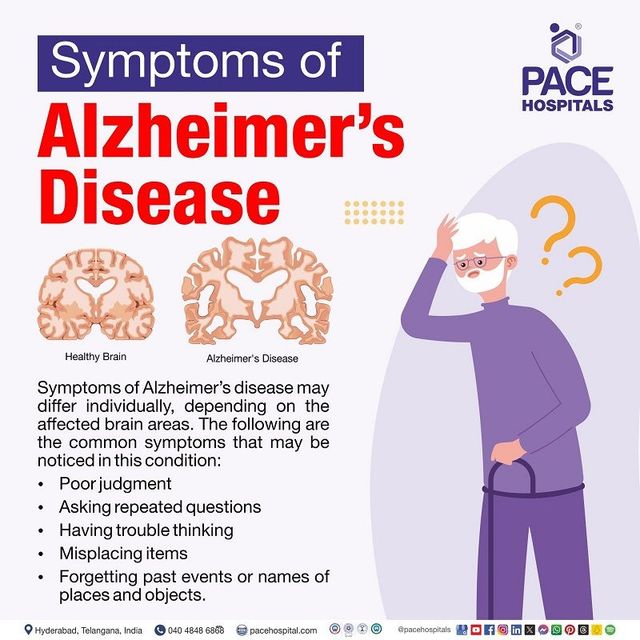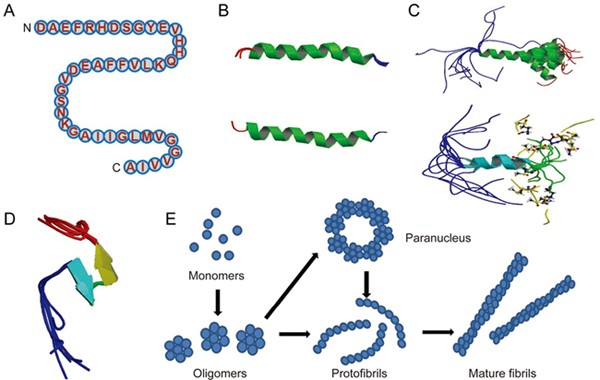Alzheimer’s is a neurodegenerative disease that falls under the broader category of dementia. Symptoms include impaired cognitive function, changes in behavior, and difficulties completing day-to-day tasks. AD most commonly impacts elderly individuals and its development can be divided into 3 stages.[1]
Early Symptoms
- Forgetting recent conversations or events

Figure 1 [2] - Misplacing items
- Forgetting the names of places or objects
- Frequent tip-of-the-tongue episodes
- repeating questions.
[1]
Middle stage symptoms
- increased confusion and disorientation
- delusions
- paranoia
- Frequent mood swings
- difficulties with spatial tasks
- short and long-term memory issues
[1]
Late stage symptoms
- loss of speech
- incontinence
- significant short and long-term memory issues
- difficulties with eating and swallowing.
[1]
Mechanisms
Amyloid beta
Amyloid beta is cut from a large protein called amyloid precursor protein by the enzymes beta and gamma-secretase. When created, the individual amyloid molecules called monomers can group up to form a variety of shapes as seen in Figure 2. Amyloid beta oligomers are small and water soluble allowing them to bind receptors and disrupt their functioning. Amyloid beta mature fibrils are large insoluble molecules that can stick together and form plaques that can clog axons and disrupt neuron function.[3]

Nuerofibrilary tangles
Neurofibrillary tangles form as a result of tau hyperphosprolation. Tau is a membrane-associated protein that helps keep microtubules organized. Phosphorylation refers to the addition of phosphate molecules and when Tau becomes hyperphosphorylated it separates from the microtubules causing them to get tangled. [4]
Insulin resistance
Insulin is a hormone that is secreted by pancreatic cells and cells in the brain. Insulin plays a role in the toxicity of amyloid beta and the formation of neurofibrillary tangles. Insulin is regulated in the brain by the enzyme Insulin-degrading enzyme. A lack of this enzyme can contribute to amyloid beta accumulation and excess insulin levels. Increased brain insulin can also hinder the clearance of amyloid beta, worsening AD pathology. Because of insulin’s role in Alzheimer’s, The disease has been called type 3 diabetes.[3]
Treatment and Prevention
Alzheimer’s is a difficult disease to manage because pathology exists many years before symptoms show. Despite this treatments do exist and while there is no cure, relief can happen.
Medications
- Memantine is an NMDA agonist and works by regulating the amount of glutamate in the brain. Glutamate is an excitatory neurotransmitter that can cause a condition called excitotoxicity. In this condition, the excessive excitatory signaling triggers the cell to take in too much calcium which does damage to the cell. Limiting the amount of glutamate and by connection the amount of excitatory signaling, excitotoxicity can be limited. The medication is prescribed for people in the middle to late stages of Alzheimer’s to help mediate symptoms. [5]
Prevention
Alzheimer’s is a very complex disease with a network of causes. Because of this complexity, There is no true way to prevent it but the evidence does show that some behaviors are correlated with lower rates of Alzheimer’s development. The Mediterranean diet which is rich in fruit, vegetables, legumes, whole grains, and monounsaturated fats like olive oil has been linked with improved cognition in individuals at risk of vascular diseases. It also helps reduce the risk of type 2 diabetes. Because both type 2 diabetes and Alzheimer’s seem to involve an issue with insulin resistance this diet could aid in Alzheimer’s prevention. [6]
[1] Graff-Radford, J. (2024, September 25). Alzheimer’s prevention: Does it exist? NHS choices. https://www.nhs.uk/conditions/alzheimers-disease/symptoms/
[2] Pace Hospitals. (2024b, December 10). Alzheimer’s disease – symptoms, causes, types and treatment. Pace Hospitals | Best Hospitals in Hyderabad, Telangana, India. https://www.pacehospital.com/alzheimers-disease-symptoms-types-causes-prevention-and-treatment
[3] Akhtar, A., & Pilkhwal Sah, S. (2020, February 18). Insulin signaling pathway and related molecules: Role in neurodegeneration and alzheimer’s disease. Neurochemistry international. https://pubmed.ncbi.nlm.nih.gov/32092326/
[4]Duan, Y., Dong, S., Gu, F., Hu, Y., & Zhao, Z. (2012, December 15). Advances in the pathogenesis of alzheimer’s disease: Focusing on tau-mediated neurodegeneration – translational neurodegeneration. BioMed Central. https://translationalneurodegeneration.biomedcentral.com/articles/10.1186/2047-9158-1-24
[5] NIH. (2023, September 12). How is alzheimer’s disease treated? | National Institute on Aging. How Is Alzheimer’s Disease Treated? https://www.nia.nih.gov/health/alzheimers-treatment/how-alzheimers-disease-treated
[6] Graff-Radford, J. (2024, September 25). Alzheimer’s prevention: Does it exist? NHS choices. https://www.nhs.uk/conditions/alzheimers-disease/symptoms/
